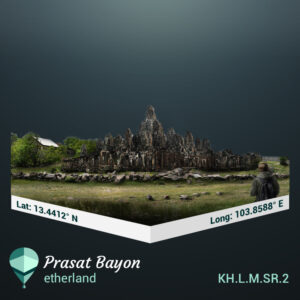 Located in Angkor, Cambodia, the Prasat Bayon is one of the most famous Khmer Buddhist temples in the world. It has been built for King Jayavarman VII in the late 12th or early 13th century. The location features 216 gigantic carvings of faces thought to be representations of Brahma. Today, Prasat Bayon Temple is part of the Angkor Archaeological Park, a UNESCO World Heritage Site.
Located in Angkor, Cambodia, the Prasat Bayon is one of the most famous Khmer Buddhist temples in the world. It has been built for King Jayavarman VII in the late 12th or early 13th century. The location features 216 gigantic carvings of faces thought to be representations of Brahma. Today, Prasat Bayon Temple is part of the Angkor Archaeological Park, a UNESCO World Heritage Site.
If stones could talk, historians would have heard millions of stories coming from the stones’ mouths in Prasat Bayon, literally.
Hidden in the dense forest of Angkor, Cambodia, Prasat Bayon is the most distinctive and unique temple for its congregational 216 large smiling faces originally carved into 49 stone towers. It was established in the 12th century by Mahayana Buddhist King Jayavarman VII as his state temple.
The temple was first established as a Buddhist place of worship. However, it was turned into a Hindu temple when king VIII reverted to Hinduism, giving orders to carve out Hindu gods. Prasat Bayon remained a Buddhist temple nonetheless where its gods were also worshipped. Separate shrines were dedicated to the worship of other gods, especially Hindu gods like Vishnu and Shiva. The current temple has images of Hindu gods as well as Buddhist sculptures. Stirring multiple debates, the exact representation of the towers’ faces, primarily arranged in four, could be the Avalokitesvara Bodhisattva or the Supreme Divinity Brahma. The faces are drawn with a broad forehead, downcast eyes, wide nostrils, and big lips.
The earliest constructed look of the temple is unknown. However, the current temple has three enclosures. The first one is made of four galleries and has two libraries on the eastern side. The enclosure starts with entrance gates and ends with four pavilions at each corner, both square-shaped. The pillars inside of the third enclosure have carvings of dancing Apsaras on the inner side, while the outer galleries have sculptures of bas reliefs signifying the historical events, wars, and daily life of 12th-century people in Angkor.
The second enclosure consists of layers of galleries, same as the first, full of bas-reliefs. The carvings in this temple section depict Hinduism with Hindu mythological, religious, and historical scenes. The galleries are placed on different levels; you will come across stairways and intersections connecting this layered yet organized maze.
The sanctuary, or third enclosure and centerpiece, is enclosed by eight towers with face carvings specific to the sanctuary. Originally square-shaped like the first enclosure’, the Sanctuary tower was made circular later on. Rising 43 meters high, it used to house a 3,6 meters tall Buddha statue, which was removed and destroyed while shifting the temple to Hinduism under Jayavarman VIII.
Prasat Bayon has been witnessing history since the 12th century, and since then, it has attracted tourists and worshippers alike. It remains one of the most enigmatic temples of the Angkor era for its symbolism, explaining its attractiveness towards visitors.